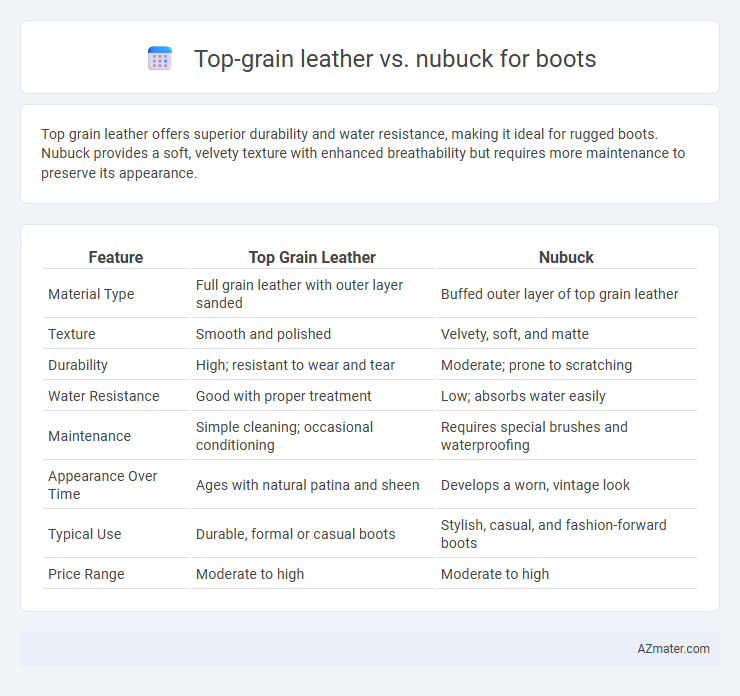Top grain leather offers superior durability and water resistance, making it ideal for rugged boots. Nubuck provides a soft, velvety texture with enhanced breathability but requires more maintenance to preserve its appearance.
Table of Comparison
| Feature | Top Grain Leather | Nubuck |
|---|---|---|
| Material Type | Full grain leather with outer layer sanded | Buffed outer layer of top grain leather |
| Texture | Smooth and polished | Velvety, soft, and matte |
| Durability | High; resistant to wear and tear | Moderate; prone to scratching |
| Water Resistance | Good with proper treatment | Low; absorbs water easily |
| Maintenance | Simple cleaning; occasional conditioning | Requires special brushes and waterproofing |
| Appearance Over Time | Ages with natural patina and sheen | Develops a worn, vintage look |
| Typical Use | Durable, formal or casual boots | Stylish, casual, and fashion-forward boots |
| Price Range | Moderate to high | Moderate to high |
Introduction to Top Grain Leather and Nubuck
Top grain leather, derived from the upper layer of the hide, offers durability and a smooth finish ideal for boots requiring robust wear resistance. Nubuck is top grain leather that has undergone sanding on the grain side, giving it a soft, velvet-like texture while maintaining strength. Both materials balance aesthetics and functionality, with top grain leather emphasizing toughness and nubuck highlighting a refined, matte appearance.
How Top Grain Leather Is Made
Top grain leather is crafted by sanding and buffing the outermost layer of the hide to remove imperfections, resulting in a smooth and durable surface ideal for boots. This process preserves the hide's strength and natural grain while enhancing resistance to moisture and wear, making top grain leather boots highly durable and easy to maintain. Compared to nubuck, which is sanded on the grain side to create a soft, velvety texture, top grain leather offers a polished finish with greater structural integrity.
Nubuck: Production and Unique Qualities
Nubuck leather is produced by sanding or buffing the outer grain of the hide, creating a soft, velvety surface with a unique texture that distinguishes it from top grain leather. Its finely sanded surface enhances breathability and offers a plush feel, ideal for comfortable and stylish boots. Unlike top grain leather, Nubuck requires delicate care due to its open pores, which absorb moisture and stains more readily, emphasizing its luxurious appearance and tactile appeal.
Visual Appearance: Top Grain vs Nubuck
Top grain leather boots exhibit a smooth, polished surface with natural grain patterns that enhance durability and classic appeal. Nubuck boots feature a soft, velvety texture achieved through sanding the outer layer, offering a matte finish and a rich, tactile feel that ages gracefully with patina. The visual contrast highlights top grain's sleek look against nubuck's rugged, suede-like appearance, influencing style and maintenance choices.
Durability and Longevity Comparison
Top grain leather offers superior durability and longevity compared to nubuck due to its thicker and more robust surface, which resists scuffs and scratches more effectively. Nubuck, while softer and more flexible, tends to show wear faster because its surface is buffed to expose a delicate grain that can absorb moisture and stains. Boot enthusiasts seeking long-lasting, rugged footwear typically prefer top grain leather for its enhanced resistance to environmental damage and prolonged lifespan.
Comfort and Flexibility for Boots
Top grain leather offers exceptional durability and a smooth finish, providing moderate flexibility that molds comfortably to the foot over time. Nubuck leather, being buffed on the outer surface, feels softer and more supple, allowing greater immediate flexibility and enhanced breathability for all-day comfort. Both materials deliver quality comfort, but nubuck excels in flexibility and a plush texture ideal for boots requiring a softer break-in period.
Water Resistance and Maintenance Needs
Top grain leather boots offer superior water resistance due to their tightly grained surface and protective finishes, making them ideal for wet conditions. Nubuck boots, while stylish with their soft, velvety texture, absorb water more readily and require regular application of water-repellent sprays to maintain durability. Maintenance for top grain leather involves occasional conditioning to prevent cracking, whereas nubuck demands more frequent cleaning and specialized waterproofing to preserve its appearance and function.
Cost Analysis: Which Offers Better Value?
Top grain leather boots typically cost more upfront than nubuck due to their durable, smooth finish and resistance to wear, providing long-term value through enhanced longevity. Nubuck boots, though often less expensive initially, require more maintenance and are prone to staining, potentially increasing overall costs over time. Evaluating the total cost of ownership, including maintenance and durability, top grain leather generally offers better value for boot investments.
Best Uses: Ideal Boot Styles for Each Material
Top grain leather, known for its durability and smooth finish, is ideal for work boots and casual styles requiring robust wear resistance and easy maintenance. Nubuck, with its soft, velvety texture and breathable surface, suits fashion-forward boots like chukka or dress boots that emphasize comfort and aesthetic appeal. Each material's unique characteristics make top grain leather perfect for rugged, everyday use while nubuck excels in stylish, lighter-use boot designs.
Final Verdict: Choosing Between Top Grain Leather and Nubuck
Top grain leather boots offer superior durability and water resistance, making them ideal for rugged use and long-lasting wear. Nubuck boots provide a softer, velvety texture and greater breathability, preferred for casual or fashion-forward footwear. When choosing between top grain leather and nubuck, prioritize durability and maintenance for outdoor activities, while opting for nubuck if softness and style are the main concerns.

Infographic: Top grain leather vs Nubuck for Boot
 azmater.com
azmater.com